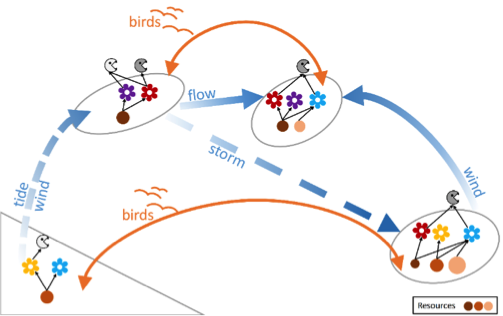Contact
Principal Investigator
Co-PI
Postdocs
Subproject 6
Network approach to metacommunities with passive dispersal mediated by ocean flows and wind fields
According to the overarching goals of the research units our project will focus on the role of passive dispersal in the emergence of biodiversity patterns in metacommunities. Our aim is to bring together two different modelling approaches: the theory of island biogeography with the idea of connectivity graphs reflecting passive dispersal (of seeds) by ocean flows and predominant wind fields on two different spatial scales (regional: 10-100km and global: 100-1000km).
Therefore, we model metacommunities as networks of networks: Each island (node of the network) has its own food web. The islands are linked to each other by a connectivity graph which is entirely determined by hydrodynamic and atmospheric flows as well as movement traits like size, density and/or terminal velocity of seeds. This connectivity graph reflecting the probabilities of different seeds to reach other islands possesses a strong seasonal and annual variability due to variable weather and flow conditions.
Employing those network models of interconnected food webs, we study the interplay between movement, tolerance and interaction traits in highly dynamic environments. We analyze the impact of the variability of connectivity graphs on source-sink dynamics, colonization of new islands and rescue effects at the base of the food web and the propagation of these effects to higher trophic levels. With this investigation we will gain insights into the role of dynamic passive dispersal for the stability of meta-ecosystems and the emergence of heterogeneous biodiversity patterns across islands. Furthermore, this network approach can be used to compare the dichotomic role of passive and active dispersal, since passive dispersal facilitates destabilization and inhomogeneous distributions of species across a meta-ecosystem due to the predominantly uni-directional dispersal, while active dispersal being mainly bi-directional leads to a homogenization and stabilization.

We validate our results on the impact of passive dispersal on the regional scale (10-100km) with data from the colonization of an emerging island in the German Bight and on the global scale (100-1000km) with abundance data of species from 8 different archipelagos worldwide.


